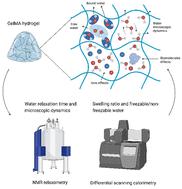当前位置:
X-MOL 学术
›
J. Mater. Chem. B
›
论文详情
Our official English website, www.x-mol.net, welcomes your feedback! (Note: you will need to create a separate account there.)
An investigation of water status in gelatin methacrylate hydrogels by means of water relaxometry and differential scanning calorimetry
Journal of Materials Chemistry B ( IF 7 ) Pub Date : 2024-04-17 , DOI: 10.1039/d4tb00053f Chun-Wei Chang 1, 2 , Bronwin L. Dargaville 1, 2 , Konstantin I. Momot 3 , Dietmar W. Hutmacher 1, 2
Journal of Materials Chemistry B ( IF 7 ) Pub Date : 2024-04-17 , DOI: 10.1039/d4tb00053f Chun-Wei Chang 1, 2 , Bronwin L. Dargaville 1, 2 , Konstantin I. Momot 3 , Dietmar W. Hutmacher 1, 2
Affiliation

|
The relationship between molecular structure and water dynamics is a fundamental yet often neglected subject in the field of hydrogels for drug delivery, bioprinting, as well as biomaterial science and tissue engineering & regenerative medicine (TE&RM). Water is a fundamental constituent of hydrogel systems and engages via hydrogen bonding with the macromolecular network. The methods and techniques to measure and reveal the phenomena and dynamics of water within hydrogels are still limited. In this work, differential scanning calorimetry (DSC) was used as a quantitative method to analyze freezable (including free and freezable bound) and non-freezable bound water within gelatin methacrylate (GelMA) hydrogels. Nuclear magnetic resonance (NMR) is a complementary method for the study of water behavior and can be used to measure the spin-relaxation of water hydrogen nuclei, which is related to water dynamics. In this research, nuclear magnetic resonance relaxometry was employed to investigate the molecular state of water in GelMA hydrogels using spin–lattice (T1) and spin–spin (T2) spin-relaxation time constants. The data displays a trend of increasing bound water content with increasing GelMA concentration. In addition, T2 values were further applied to calculate microviscosity and translational diffusion coefficients. Water relaxation under various chemical environments, including different media, temperatures, gelatin sources, as well as crosslinking effects, were also examined. These comprehensive physical data sets offer fundamental insight into biomolecule transport within the GelMA hydrogel system, which ultimately are important for drug delivery, bioprinting, as well as biomaterial science and TE&RM communities.
中文翻译:

利用水弛豫法和差示扫描量热法研究明胶甲基丙烯酸酯水凝胶中的水状态
分子结构和水动力学之间的关系是用于药物输送、生物打印以及生物材料科学和组织工程与再生医学(TE&RM)的水凝胶领域的一个基本但经常被忽视的课题。水是水凝胶系统的基本组成部分,并通过氢键与大分子网络结合。测量和揭示水凝胶内水的现象和动态的方法和技术仍然有限。在这项工作中,差示扫描量热法 (DSC) 被用作定量方法来分析甲基丙烯酸明胶 (GelMA) 水凝胶中的可冻结水(包括游离水和可冻结结合水)和不可冻结结合水。核磁共振(NMR)是研究水行为的补充方法,可用于测量与水动力学相关的水氢核的自旋弛豫。在本研究中,采用核磁共振弛豫测量法,利用自旋-晶格 ( T 1 ) 和自旋-自旋 ( T 2 ) 自旋弛豫时间常数研究 GelMA 水凝胶中水的分子状态。数据显示结合水含量随着 GelMA 浓度的增加而增加的趋势。此外,T 2值进一步用于计算微粘度和平移扩散系数。还检查了各种化学环境下的水松弛,包括不同的介质、温度、明胶来源以及交联效应。这些全面的物理数据集提供了对 GelMA 水凝胶系统内生物分子运输的基本见解,这最终对于药物输送、生物打印以及生物材料科学和 TE&RM 社区非常重要。
更新日期:2024-04-17
中文翻译:

利用水弛豫法和差示扫描量热法研究明胶甲基丙烯酸酯水凝胶中的水状态
分子结构和水动力学之间的关系是用于药物输送、生物打印以及生物材料科学和组织工程与再生医学(TE&RM)的水凝胶领域的一个基本但经常被忽视的课题。水是水凝胶系统的基本组成部分,并通过氢键与大分子网络结合。测量和揭示水凝胶内水的现象和动态的方法和技术仍然有限。在这项工作中,差示扫描量热法 (DSC) 被用作定量方法来分析甲基丙烯酸明胶 (GelMA) 水凝胶中的可冻结水(包括游离水和可冻结结合水)和不可冻结结合水。核磁共振(NMR)是研究水行为的补充方法,可用于测量与水动力学相关的水氢核的自旋弛豫。在本研究中,采用核磁共振弛豫测量法,利用自旋-晶格 ( T 1 ) 和自旋-自旋 ( T 2 ) 自旋弛豫时间常数研究 GelMA 水凝胶中水的分子状态。数据显示结合水含量随着 GelMA 浓度的增加而增加的趋势。此外,T 2值进一步用于计算微粘度和平移扩散系数。还检查了各种化学环境下的水松弛,包括不同的介质、温度、明胶来源以及交联效应。这些全面的物理数据集提供了对 GelMA 水凝胶系统内生物分子运输的基本见解,这最终对于药物输送、生物打印以及生物材料科学和 TE&RM 社区非常重要。



























 京公网安备 11010802027423号
京公网安备 11010802027423号